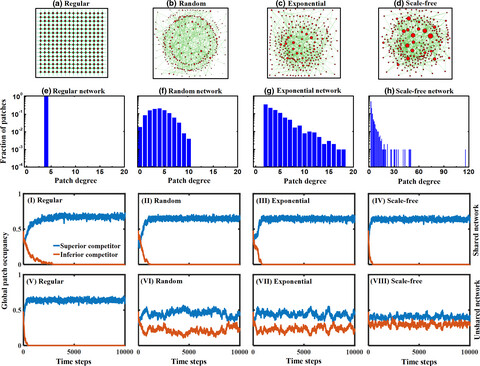Journal list menu
Export Citations
Download PDFs
Cover Image
Cover Image: Volume 24 Number 1, January 2021
- Page: i
- First Published: 12 December 2020
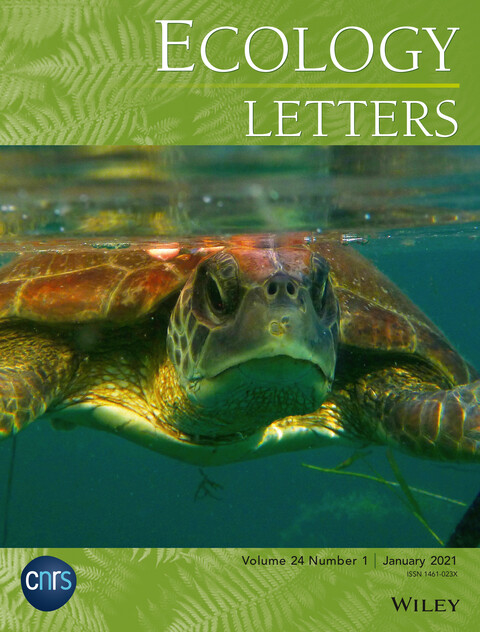
The cover image is based on the Review And Synthesis The context dependence of non-consumptive predator effects by Aaron J. Wirsing et al., https://doi.org/10.1111/ele.13614.
Photo Credit: Brendan Talwars.
Issue Information
Viewpoints
We live in a changing world, but that shouldn’t mean we abandon the concept of equilibrium
- Pages: 3-5
- First Published: 25 October 2020
Ecological systems are no longer at equilibrium, but over much of the history of the Earth, the natural world has been in stationary states, that are punctuated by periods of transience. Just because we have knocked our planet away from a stable state, doesn't mean we have to abandon the concept of equilibrium when we strive to understand the dynamics of the natural world.
Ideas and Perspectives
Elements of disease in a changing world: modelling feedbacks between infectious disease and ecosystems
- Pages: 6-19
- First Published: 12 October 2020
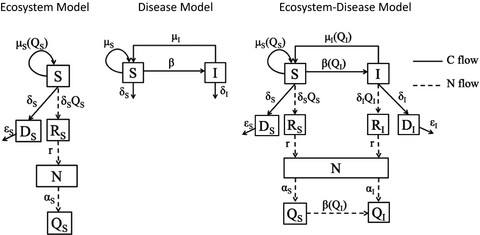
In spite of the rich potential for new insights at the intersection of disease and ecosystem ecology, we currently lack a framework for predicting the breadth of ways that infectious disease, particularly in autotrophs, could impact elemental fluxes and stocks and, conversely, the ways in which recycling of nutrients from dead hosts could alter disease dynamics in living hosts. Here, we consider why this impasse has occurred and overcome it by developing a stoichiometric model with disease. We show that integrating these subdisciplines of ecology using a stoichiometric modelling framework provides a common currency, opening the door to new questions and insights into the interplay of disease dynamics, ecosystem processes and changing biogeochemical cycles.
Letters
Adult survival probability and body size affect parental risk-taking across latitudes
- Pages: 20-26
- First Published: 07 October 2020
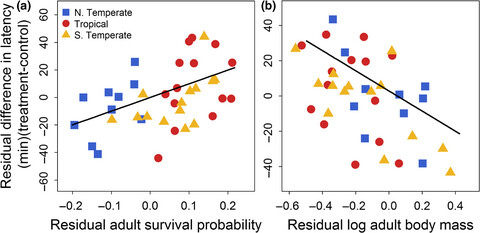
Parents faced with a predator must choose between their own safety versus taking care of their offspring. Each choice can have fitness costs. Consistent with life-history theory, we found that longer-lived species were less willing to return to care for their offspring in the face of a nearby robotic predator when compared to shorter-lived species. But contrary to other studies, we also found that smaller species were more risk averse than larger species. Our results highlight the importance of adult survival and relative vulnerability as selective forces in life history and behavioural evolution.
Microclimate limits thermal behaviour favourable to disease control in a nocturnal amphibian
- Pages: 27-37
- First Published: 06 October 2020

While epizootics increasingly affect wildlife, it remains poorly understood how the environment shapes most host–pathogen systems. Here, we employ a three-step framework composed of laboratory experiments, fieldwork and mechanistic modelling to study how microclimate steers the ability of fire salamanders to counter the fungal pathogen Batrachochytrium salamandrivorans (Bsal) through thermal behaviour. Our results demonstrate how host innate defences against epizootics may remain constrained in the wild, which predisposes to range-wide disease outbreaks and population declines.
A place to land: spatiotemporal drivers of stopover habitat use by migrating birds
- Pages: 38-49
- First Published: 07 October 2020
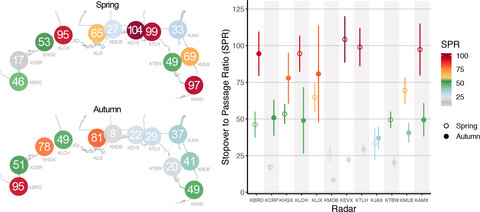
Using 8 years of data from 12 weather surveillance radars, we found over 50% of the birds migrating through the south-eastern US coastlines stop there, totalling c. 1.2 to 2.0 billion birds each spring and autumn. The drivers of stopover habitat use differed between spring and autumn migration, suggesting seasonal differences in habitat function. Furthermore, disparities in disproportionate selection and absolute abundance at stopover sites revealed potential migratory bottlenecks where geography or restricted habitat may disproportionately concentrate birds along migration routes, highlighting that density of use alone is not a comprehensive measure of the conservation value of a stopover site for migrating birds, a topic that has not been addressed during migration. The question of where and when migrating communities stop en masse relative to passage rates, and within and between seasons, remains an open question for migration systems globally.
Dispersal network heterogeneity promotes species coexistence in hierarchical competitive communities
- Pages: 50-59
- First Published: 07 October 2020
Spatial co-localisation of extreme weather events: a clear and present danger
- Pages: 60-72
- First Published: 12 October 2020
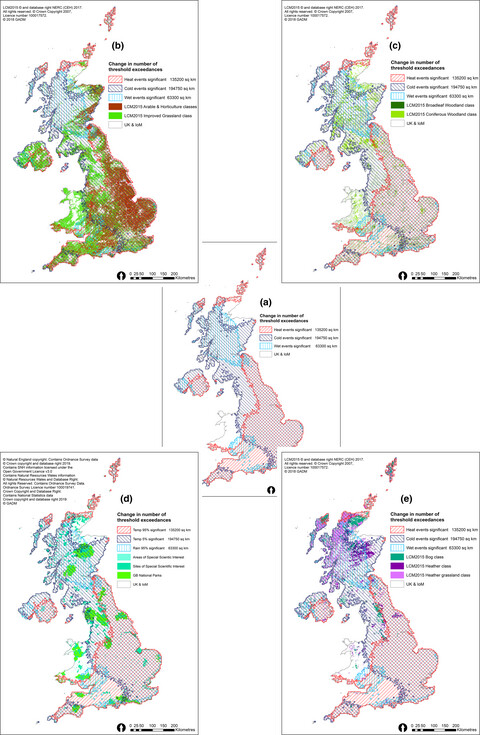
Extreme weather events have become a dominant feature of the narrative surrounding changes in global climate with large-scale implications for ecosystem function. Based on the UK Met Office’s long-term high-resolution temperature and rainfall records, we present the first evidence demonstrating significant increases in the magnitude, direction of change and spatial co-localisation of extreme weather events since 1961. Combining this new understanding with land-use data sets allowed us to assess the likely consequences of these events on future agricultural production and conservation priority areas.
Landscape simplification increases vineyard pest outbreaks and insecticide use
- Pages: 73-83
- First Published: 13 October 2020

Diversifying agricultural landscapes may mitigate biodiversity declines and improve pest management. We used a 13-year government database to analyse landscape effects on European grapevine moth (Lobesia botrana) outbreaks and insecticides across c. 400 Spanish vineyards. Our results suggest increasing landscape complexity may mitigate pest outbreaks and insecticide applications.
Selection against immigrants in wild seabird populations
- Pages: 84-93
- First Published: 14 October 2020
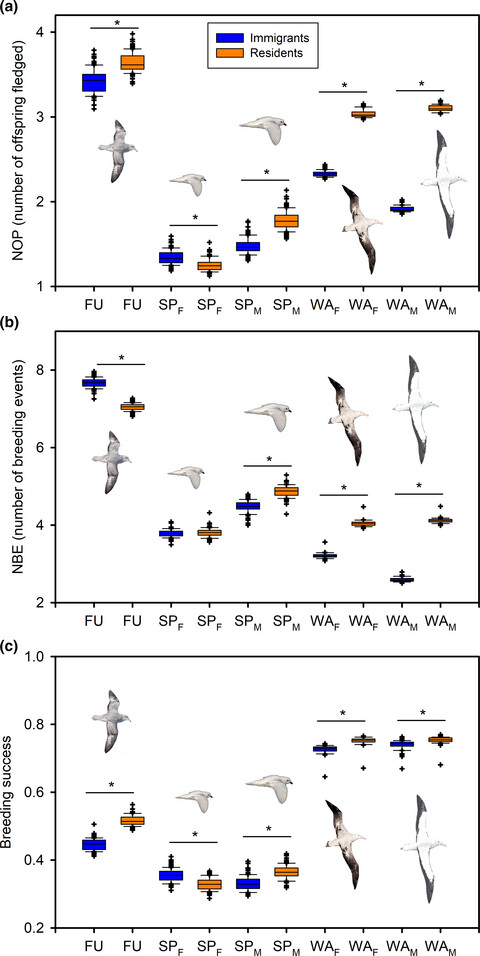
We show that immigrants have a lower fitness than residents in three wild seabird populations. Across all species during a 32-year period, immigrants made on average −9 to 29% fewer breeding attempts, had 5–31% fewer fledglings, had 2–16% lower breeding success and produced 6–46% fewer recruits. Female immigration and male residency were favored through differences in breeding performance. We provide evidence for selection against immigrants in wild populations of long-lived species and our results are consistent with female-biased dispersal in birds being driven by asymmetric limiting resources and the competitive ability of dispersers vs. non-dispersers.
Clockwise and counterclockwise hysteresis characterize state changes in the same aquatic ecosystem
- Pages: 94-101
- First Published: 20 October 2020
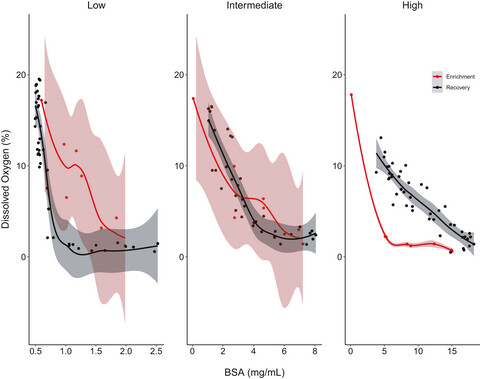
Incremental increases in a driver variable, such as nutrients or detritus, can trigger abrupt shifts in aquatic ecosystems, which may exhibit hysteretic dynamics and a slow return to the initial state. We used the ecosystem found in the pitcher plant Sarracenia purpurea as a model system for understanding hysteretic dynamics by observing changes in a dissolved oxygen in replicated ecosystems enriched with bovine serum albumin, a molecular substitute for detritus. We observed clockwise and novel counterclockwise hysteresis and demonstrated that a complex range of hysteric dynamics can occur in a natural ecosystem in response to manipulation of a single driver variable.
Seasonal environments drive convergent evolution of a faster pace-of-life in tropical butterflies
- Pages: 102-112
- First Published: 24 October 2020
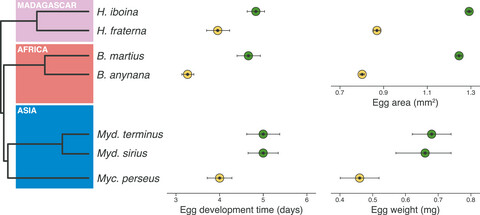
Using tropical Mycalesina butterflies as a model system, we show that these butterflies have colonised seasonal savannahs from forest ancestors independently across three major radiations in Africa, Asia and Madagascar. By quantifying several life-history traits for a replicate pair of forest and savannah species across all three radiations, we show that savannah species exhibit faster life-history strategies than forest species. We conclude that the evolution of a faster pace-of-life in savannah species was crucial to persist in such seasonal environments.
Reviews and Syntheses
The context dependence of non-consumptive predator effects
- Pages: 113-129
- First Published: 29 September 2020

Non-consumptive predator effects are now widely recognised for their capacity to shape ecosystem structure and function, but forecasting their propagation through particular communities remains a challenge. Focusing on plasticity in prey anti-predator behaviours, we conceptualise the multi-stage process by which predators trigger direct and indirect NCEs, review potential drivers of contingencies into three key categories (properties of the prey, predator and setting), and provide a general framework for predicting both the nature and strength of direct NCEs. Looking ahead, we highlight two key knowledge gaps that continue to impede a comprehensive understanding of non-consumptive predator–prey interactions and their ecosystem consequences; namely, insufficient empirical exploration of context-dependent indirect NCEs and the ways in which direct and indirect NCEs are shaped interactively by multiple drivers of context dependence.
Mechanisms underlying host persistence following amphibian disease emergence determine appropriate management strategies
- Pages: 130-148
- First Published: 16 October 2020
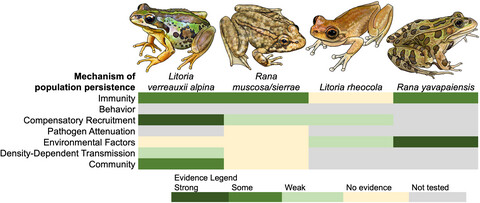
We synthesize research on host, pathogen, environmental and community factors and overview the information required to support each mechanism, and current evidence. Using this information, we illustrate how the mechanisms that drive long-term host population dynamics determine the most effective conservation management strategies.
Seeing through the static: the temporal dimension of plant–animal mutualistic interactions
- Pages: 149-161
- First Published: 19 October 2020
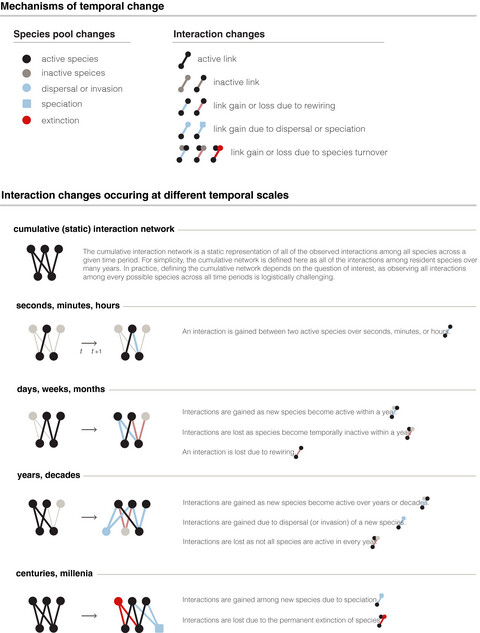
We review the growing literature on the temporal dynamics of plant–animal mutualistic networks, discuss potential mechanisms underlying such change and identify the research frontiers in the study of the temporal dynamics of mutualistic networks. Our synthesis highlights the importance of considering the temporal dimension for understanding the ecology and evolution of complex webs of mutualistic interactions.





